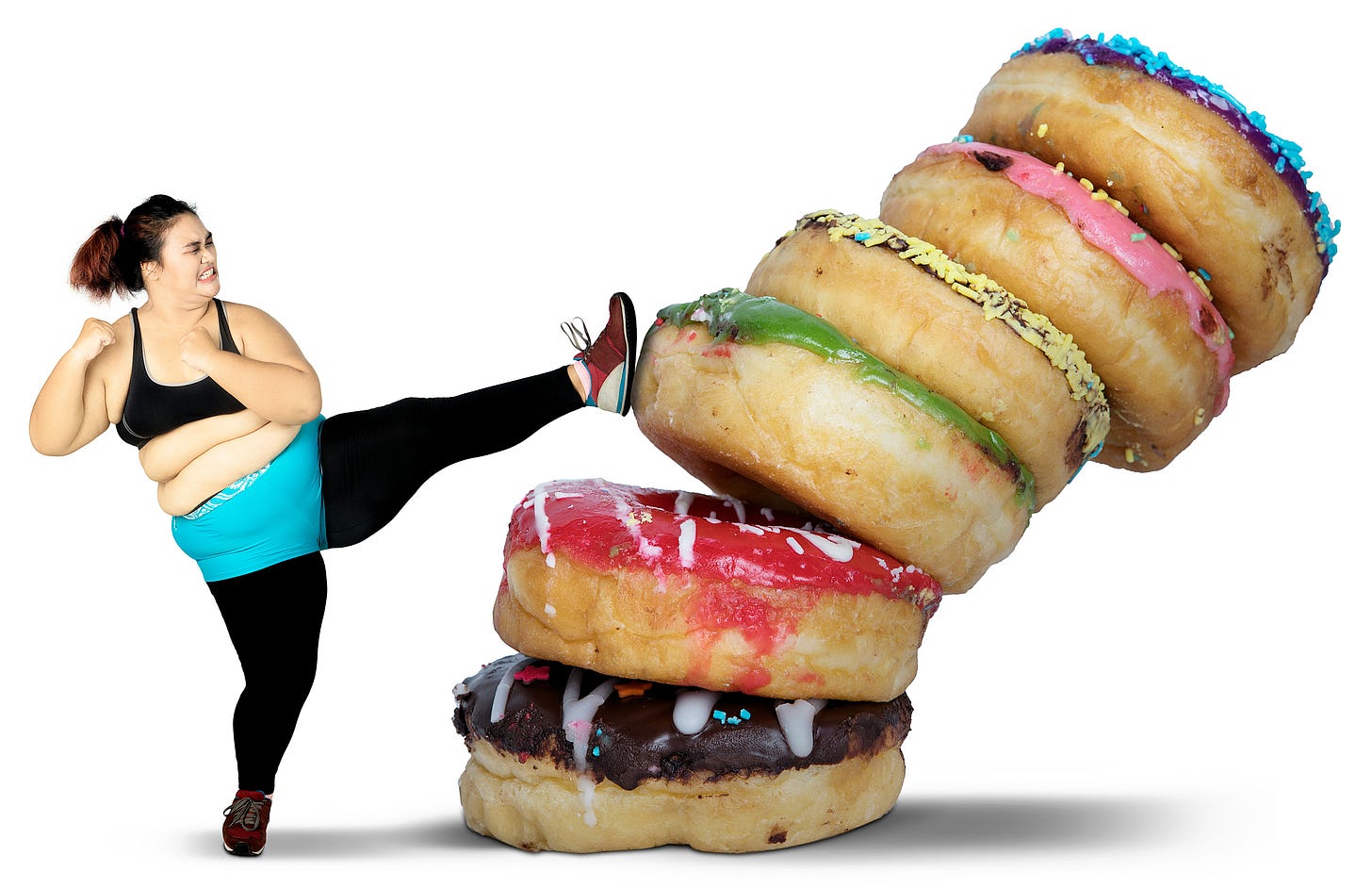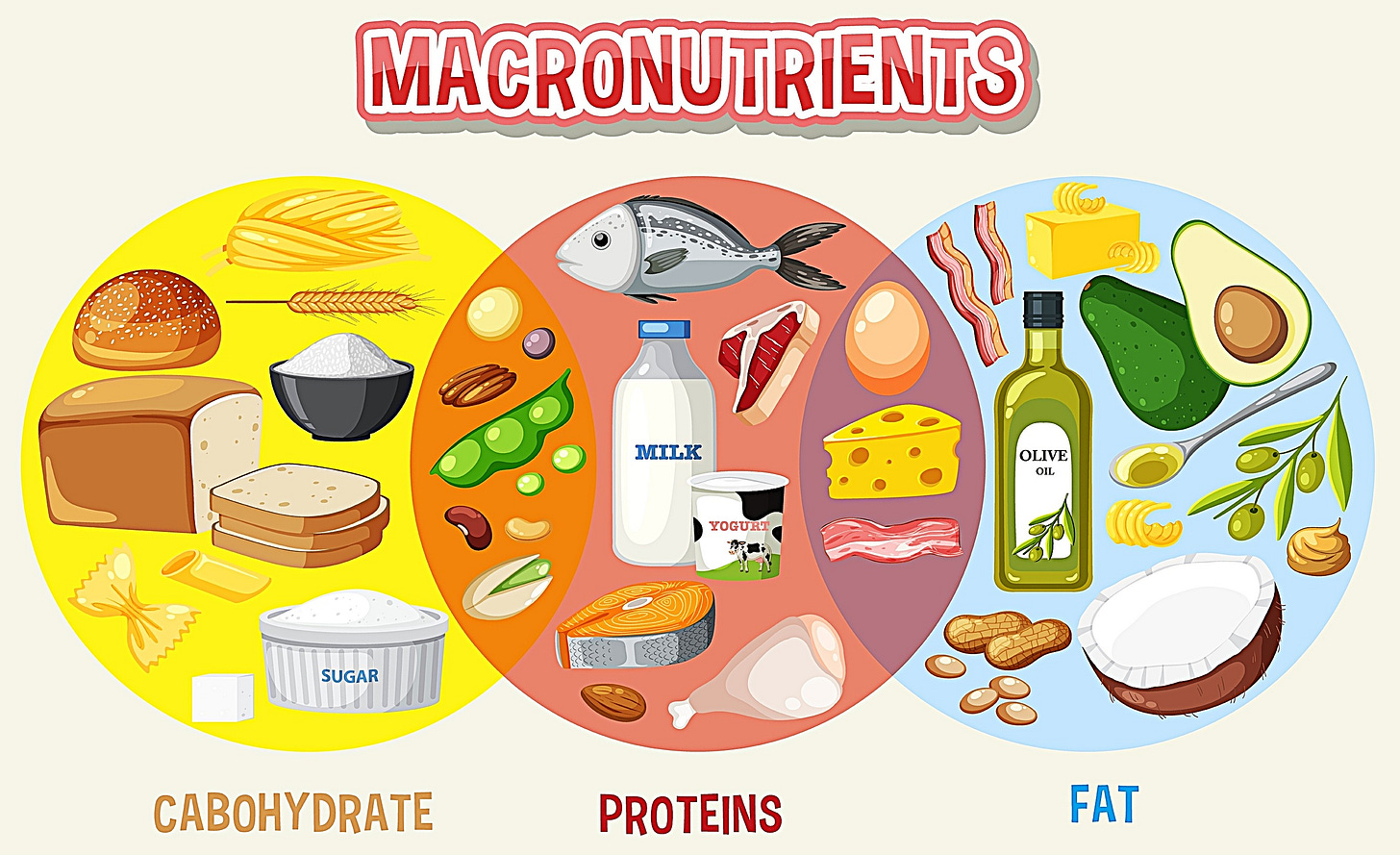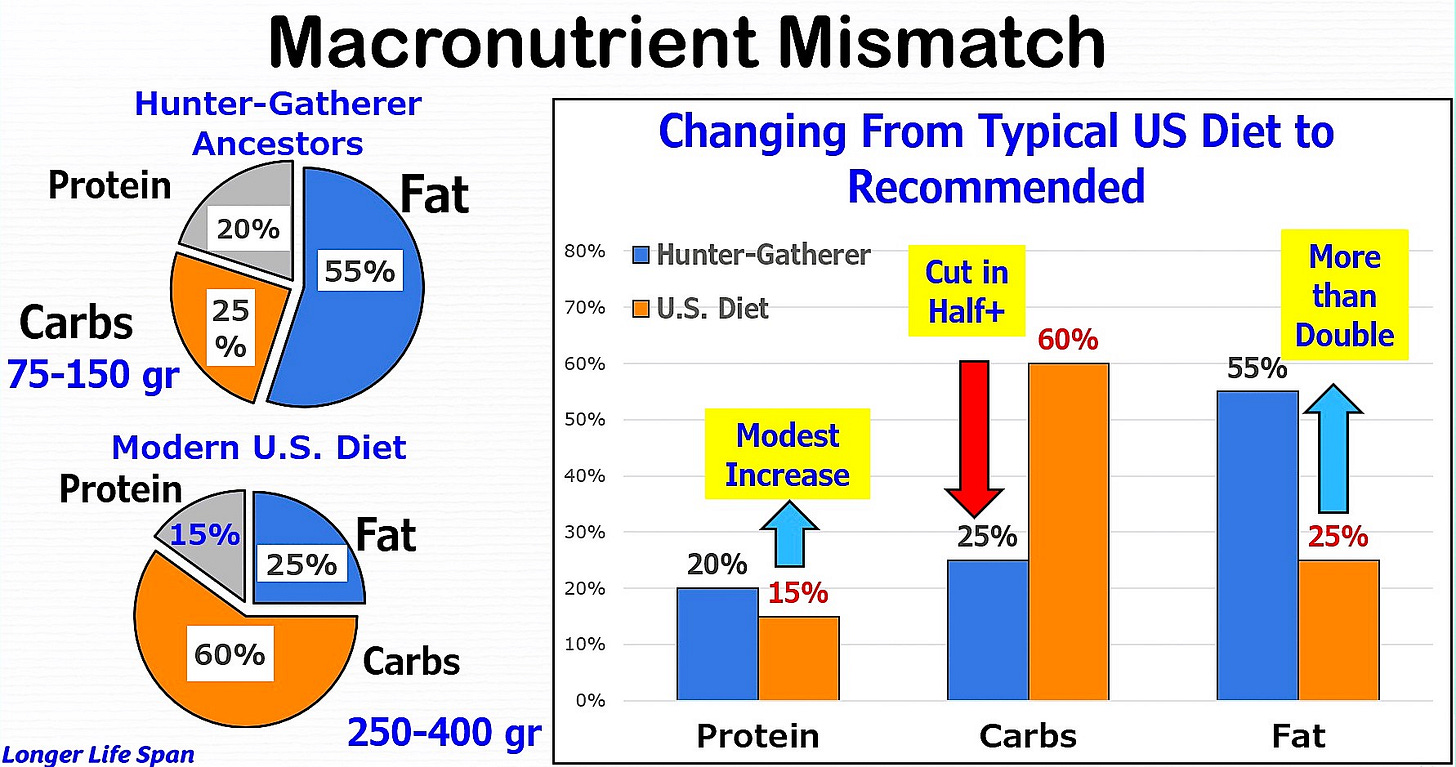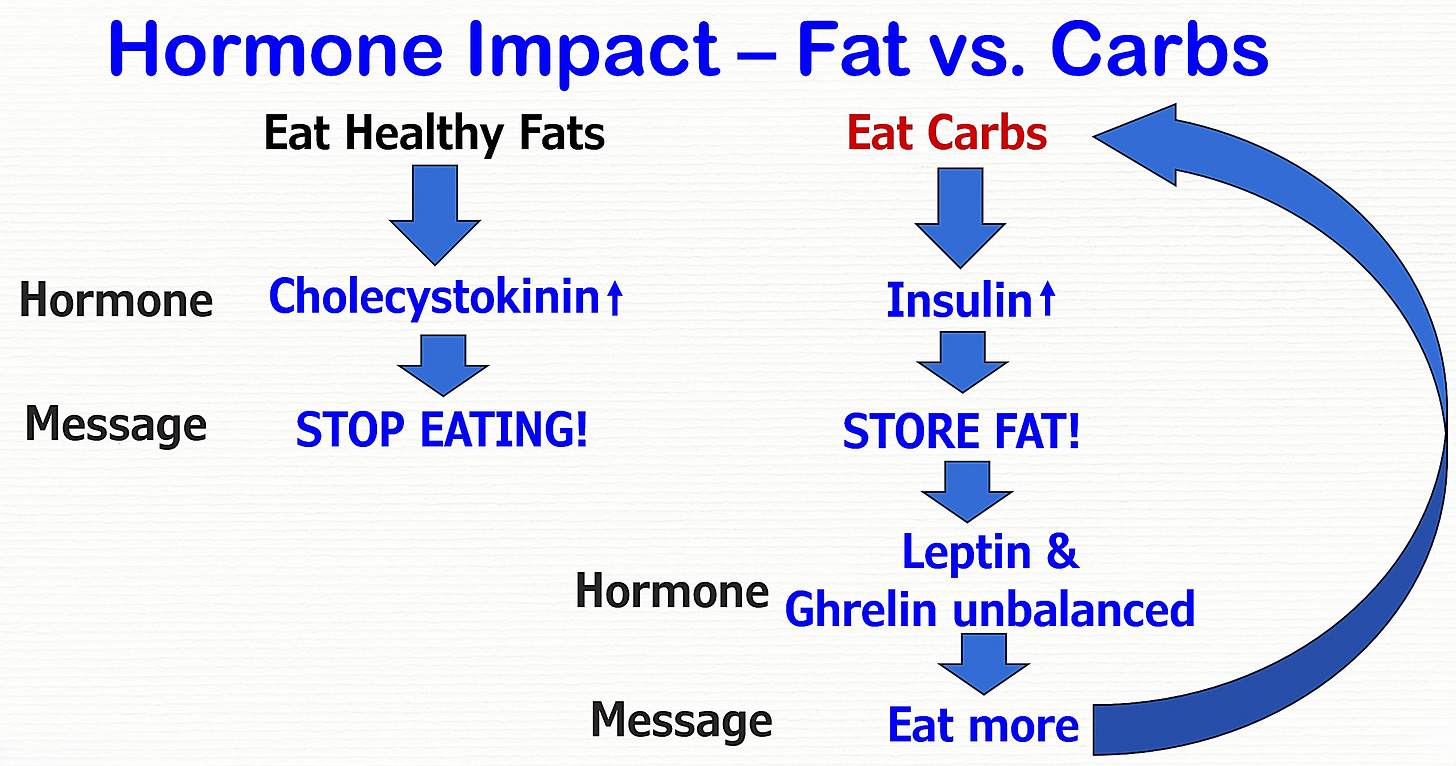Reduce Carbs/Feel Great - Practical Strategies
You can do it! Avoid the diabesity disaster facing 93% of us
Go for it, girl! Don’t we admire someone who gives up donuts and other refined grains to be healthier? But this reaction may imply the extra pounds are their fault in the first place! An individual’s weight becomes a way to praise them or judge them, speak well or poorly of them, accept or reject them. We all know people who shame those who are overweight or obese and praise those who are not. Either way, we assume their weight is their fault.
But it is much more complicated than that. Our toxic food supply with addictive ingredients, weak or nonexistent regulation of chemicals in food and other products, an inside, sedentary culture, and widespread misinformation from food companies, non-profits, and even government agencies (like a food pyramid that emphasized refined grains) are all responsible for the obesity crisis we face today. In fact, when we see an overweight or obese person, we should not see them as an undisciplined failure but someone who is metabolically ill on the inside.
When researchers in the 1970s discovered that obesity and diabetes are different elements of the same disease, they coined the term “diabesity” to capture the whole spectrum of our most common and deadly metabolic illness. Being overweight is just an early symptom. Ninety-three percent of adults in the U.S. and many children are on this continuum that starts with excess weight and leads to insulin resistance, then prediabetes and type 2 diabetes. Being overweight or obese is just one early symptom of the disease, and understanding “diabesity” helps us look past the unattractive appearance to see it. Many toxic elements in our lifestyle cause this disease, but the unholy trinity of toxic foods we eat is a primary trigger.
The Unholy Trinity
Most of us are already familiar with the “unholy trinity” so prevalent in our food supply and culture. These three toxic elements—refined carbs, sugar, and seed oils—destroy our health today and lead to future chronic disease. But these ingredients are so pervasive in our diet that we may start to feel overwhelmed trying to avoid them. But we must avoid them if we are to feel better today and prevent the chronic disease that eighty percent of us have in our future! This article will explore the critical nature of this lifestyle “switch” and how to make it easier.
You might think ultra-processed food should also be part of this group, and you would be right. Its membership is automatic because all ultra-processed foods have one and usually two or more of these toxic ingredients as key components.
Before we discuss some practical strategies, we review below the impact on your body of the unholy trinity. Click the “more information” links for other relevant articles on this site.
Refined Sugar
Examples: Added sugar, high fructose corn syrup, and most sugar substitutes.
Short Term Impact: Bloating, digestive problems, glucose spikes and crashes leading to fatigue, irritability, and increased hunger soon after consumption.
Long term Impact: Accelerated aging, high blood pressure, heart disease (heart attack and strokes), Alzheimer’s, migraines, neuropathy, sexual dysfunction, breast and colon cancer, skin diseases, muscle loss, gout, diabetes, obesity, decreased bone mass, non-alcoholic fatty liver disease.
More information: “The hidden poison…” and “The Train Wreck…”
Seed Oils
Examples: Industrially refined “vegetable” oils heavily used in processed foods, restaurants, margarine, and other butter substitutes, including canola, soybean, corn, sunflower, safflower, rice bran, grapeseed, and cottonseed oil.
Short Term Impact: Less energy, brain fog, domino effect of free radicals that destroys cells, insulin resistance, displaces healthy fats like omega-3 oils.
Long Term Impact: Chronic inflammation leading to diabesity (obesity, type 2 diabetes), atherosclerosis, and a contributing factor to many other chronic diseases.
More information: “The Greatest Hidden Threat: Part 1” and “…Part 2”
Refined Carbohydrates
Examples: Baked goods (bread, bagels, croissants, muffins, donuts, pastries), breakfast items (pancakes, waffles, most cereals, instant oatmeal, cream of wheat), pasta/noodles (spaghetti, macaroni, instant ramen noodles, egg noodles), other processed grain items (wheat added to anything, white rice, corn, couscous), snacks (crackers, chips, pretzels, rice cakes, microwave popcorn), sweets (cakes, cookies, brownies, pie crust, desserts).
Short Term Impact: Poor satiety despite high calories, leading to overeating and cravings, blood sugar spikes, carb addiction, bloating/digestive problems, blocking of nutrient absorption (especially iron and zinc).
Long Term Impact: Insulin resistance and diabesity, increased visceral fat leading to non-alcoholic fatty liver disease, inflammation (a primary cause of most chronic illness, including arthritis, heart disease, MS, cancer, Alzheimer’s, dementia, diabetes, and neurodegenerative diseases like Parkinson’s).
More information: “The Frankenstein Food” and “The Carb Hormone Trap.”
The extensive list of refined carbohydrates we consume is shocking, isn't it? These products are not only inconsistent with our biology that God has created but poison our body in multiple ways. However, carbohydrates can be a confusing macronutrient.
Macronutrient Mismatch
What are macronutrients, anyway? I find them sometimes confusing categories of foods that are helpful only if we understand them. Let me clear up the confusion first.
The first confusion: the diagram doesn’t illustrate the labels, but examples of foods that contain them. A carbohydrate (or carb) is an organic molecule including sugars, starches, and fiber; proteins are large biomolecules with amino acids; and fats are special fatty acid molecules. If a food contains a high content of a molecule, it is put in a group with the same name, and then we often use that name as shorthand for the group.
The second confusion: the categories overlap because many foods have more than one type of molecule, like cheese that has both protein and healthy fat. Many people might also disagree on exactly how to categorize a particular food.
The third confusion: the scheme is not comprehensive or consistent. For instance, sugar is not really a food, just a toxic, addictive substance we invented and then manufactured. Some things are not shown, like carbonated soft drinks that clearly fit in the carbohydrate category, but where do you put fruits and vegetables?? Technically, they are considered carbs, but of a vastly different type than refined carbs like bread and pasta. They consist of an incredibly nutritious combination of vitamins, minerals, phytonutrients, and fiber with only a modest amount of non-fiber carbs. Although it is usually put in the carb group, this conundrum emphasizes the importance of macronutrient quality.
Looking just at quantity, the chart below shows the dramatic changes in our consumption of these food categories since our bodies were carefully designed using a couple million years of evolution.
You still have the same body design as your ancestors did at least several hundred thousand years ago, so think of the top pie chart as a page out of the “operator manual” for your body. It differs dramatically from the modern American diet in the other pie chart, so you may need to make the changes represented by the bar chart to the right to align your body and health with your master design. In fact, these macro shifts are critical to live your best life today and prevent chronic disease in the future. (As just one example, the reduction in carbs shown is one of the best strategies to prevent heart disease, the number one cause of death, better than any drug available.)
But don’t forget quality. When choosing protein, avoid processed meats, conventionally raised (“factory farmed”) meat, and farmed seafood. The carb slice in the top pie (God’s master design) represents only wild, organic fruits, vegetables, nuts, and seeds—not any of the refined carbs that dominate our standard American fare. These refined carbs are the ones you must eliminate from your diet.
The primary fats in the top pie slice are animal fats from meat, organs, and brains plus some natural plant fats from seeds, nuts, and fruits like olives and coconuts. In addition to adding these healthy fats to your diet, you must also change the mix by eliminating the toxic vegetable/seed oils that make up eighty percent of the fat that the average American consumes.
The Carb Addiction Problem
Why is it so hard to give up carbs? Some people have told me they are addicted to carbs or cannot give them up. It turns out they are right! Refined carbs, especially those made with wheat, break down into compounds that bind to the same receptors triggered by heroin or morphine. The mild euphoria produced can encourage habitual eating, cravings, and even addiction.
However, these cravings and addiction can be easily broken just by abstaining from refined carbs like bread, pasta, snacks, and pastries for three or four weeks, with cravings eliminated for most people in two months. The benefits are immediate, dramatic, and long term (see section on carb impact above.)
The other element that drives the carb cycle of overeating is your hormones. A high volume of carbs in your system triggers your hormones to create havoc, as shown by the diagram below:
Healthy fats (grass-fed butter, plain yogurt, avocados, eggs, cheese, coconut oil, tree nuts) are both critical for your health and very satisfying. They are your most efficient energy source and release the cholecystokinin hormone that signals your brain you should stop eating.
Carbs, on the other hand, do the opposite. First, the carbohydrate molecules are quickly transformed into sugar molecules. Next, these sugars trigger a release of insulin to get them out of your blood and into your fat cells. The high volume of carbs we eat gradually over taxes this system and creates insulin resistance and extra weight—the first symptoms of diabesity, which lead unavoidably to chronic illness long before you are diagnosed with diabetes.
Two of the biggest culprits are added sugar and refined grains, which also disrupt the leptin and ghrelin hormones which tell your brain when to start and stop eating, creating a deadly cycle. Your body was never designed to handle refined grains that do not exist in nature, and they are so nutrient poor that your body may be desperately trying to get you to eat natural whole foods that will feed, build, heal, and restore your body (see “Why Are You So Malnourished…”).
Making the Switch
Now that you know the dangers of the unholy trinity and why you are tricked into craving them, how do you switch away from them? And what are the alternatives? In general, you will switch from (a) sugar-sweetened beverages and processed foods to natural alternatives, (b) from refined carbs to healthy fats and nutrient-dense, low-glycemic fruits and vegetables (quality carbohydrates), and (c) from toxic vegetable oil to healthy fats.
This may sound like a wholesale change to your lifestyle, and for many, it is. But the benefits of vibrant health, better body and brain power, better ability to do what you want as you age, and more life in those years without chronic disease are worth it! Here is a rough plan to make it happen:
#1-Guage your position on the diabesity continuum and food intake (week 0)
We are all on this continuum, but only seven percent of us are optimal. To gauge your progress, you need to determine your starting point. Identify both your insulin sensitivity, your weight, and your body fat status:
These blood tests are available from Life Extension, LabCorp on Demand, Quest, Request-a-Test, and others, which may include your doctor if he/she is willing. The two starred indices are key, and you may have to calculate them yourself. If they are not conclusive, you should consider the gold standard Oral Glucose Tolerance Test (OGTT) with Insulin (available from Quest and LabCorp).
Also check your weight against a Body Mass Index chart (search for “BMI chart” online). An index of 18.5 to 24.9 is normal, 25-29.9 is overweight, and 30+ is obese. Keep track of both your BMI and weight. In addition, if you have a body composition or smart scale, measure your subcutaneous fat (the kind you can pinch) and visceral fat (the kind you cannot see around your organs). If your belly fat is firm, it is likely to be mostly visceral fat, the most dangerous type.
Another key measure is waist size, with 35” or higher for women and 40” or higher for men indicating a symptom of diabesity.
Monitor your progress on all these measures every 3-6 months, unless optimal, then every twelve months (also see “The Train Wreck - Insulin Resistance”).
Finally, use the free Cronometer or Zoe app for a couple of weeks to assess how many grams of carbs you eat per day and the type of nutrients you are getting. Reassess your intake after week six.
#2-Toss the seed oils (week 1)
This is one of the easiest steps to start with. The seed or “vegetable” oils include canola, soybean, corn, sunflower, safflower, rice bran, grapeseed, and cottonseed oils and are used in processed foods, restaurants, margarine, and other butter substitutes. They are toxic but also colorless and tasteless, so you will not miss them a bit.
Remove these from your kitchen and use olive oil, coconut oil, Chosen brand avocado oil, tallow, lard, or butter instead.
Read labels carefully on any packaged food and reject any that contain these oils (they are everywhere!).
Avoid fast food and inexpensive restaurants that use these oils heavily!
For all other restaurants, call ahead or on arrival, ask which menu items use seed or “vegetable” oils in ingredients or in preparation before you order. Avoid anything fried. They may be willing to prepare an item using a healthy alternative to seed oil. The Seed Oil Scout app may also help.
#3-Cut the sugar from your diet (weeks 2-3)
Remember that added, refined sugar is not natural, but a toxic poison we manufacture. Gradually reduce it over two or three weeks to a modest amount, no more than 25 grams for women or teens and no more than 35 grams for men per day. Read labels and use the Cronometer app to determine your consumption.
Avoid going cold turkey to give your microbiome and gut a chance to adjust. You may experience some withdrawal symptoms (nausea, headache, fatigue), but they will go away after a week or so. Start by eliminating soft drinks and other sweetened beverages (substitute water, flavored water without added ingredients, unsweetened herbal tea, and/or 6 oz of low sugar kombucha).
Next skip the worst high-sugar offenders that may also contain seed oils and grains: pastries, donuts, most breakfast cereals, cookies, candy, ice cream, desserts, etc.
Store your sugar bowl in a closet. If you need something sweet, use berries or other low-glycemic fruit. See below for additional tips on what to eat instead of these foods you are eliminating.
#4- Eliminate the worst carbs: refined grains (week 4)
In some ways, refined grains are worse than sugar because of how frequently we consume them and how we view them as healthier than sugar when they are not. Once you swallow a refined grain product, it quickly turns into sugar. This helps explain why bread will raise blood glucose farther and faster than table sugar.
Because you have gotten past most of the possible withdrawal symptoms in step #3, you should go cold turkey with refined grain products. Any further withdrawal symptoms will be minimal and will disappear in a few days. Here are the most important foods to eliminate:
Bread, muffins, croissants, bagels, pastries, donuts (substitute sprouted grain muffins/bread [freezer], almond flour products)
Pizza made from wheat or other grain (substitute cauliflower or almond flour pizza)
Taco shells, tortilla and other wraps made from flour (substitute almond/cassava products, like Siete brand)
Chips, crackers, and other snacks made with wheat, rye, barley, and triticale (substitute almond/cassava products, like Siete brand)
Cereals made from wheat (substitute small quantities of gluten-free oatmeal or non-grain cereals from Purely Elizabeth or Seven Sundays)
You may find many more good substitutions with low glycemic impact, few carbs, and better nutrient profiles, but remember that many substitutes will be temporary. In most cases, they are still carbs, just healthier ones. Future steps will see you refining your diet to improve the quality of the carbs and reduce the total amount.
#5- Dramatically increase the good fats (week 5)
You have already begun this step in #2 by tossing the seed/vegetable oils and replacing them with healthy natural oils like coconut oil and butter (ideally from grass-fed cows). Now make healthy fats a more substantial part of your diet by increasing the consumption of these foods:
Natural, unprocessed firm to hard organic or European cheese
Butter or ghee, from grass-fed cows, kefir, plain yogurt (eat with berries instead of cereal), or best, make your own therapeutic designer yogurt (see “The Friendly Foreigners Inside You.”
Lots of organic eggs from pasture raised chickens (eat 2-3 a day)
Avocados, tahini, olives, coconut (put shreds on cereal), tree nuts like walnuts, almonds, pecans, macadamia nuts, pistachios, and hazelnuts, and seeds (chia seeds, basil seeds)
Wild fatty fish (salmon, albacore tuna, mackerel, sardines) and animal fat from grass-fed cows, lamb, and venison (you should also take fish oil supplements)
Adding Medium Chain Triglyceride (MCT) oil to your coffee or taking MCT tablets (C8/10 is best) will give your body some quickly absorbable quality fats
You will need to eat a lot of these fats to increase your intake to 55% of your diet as shown in the macronutrient chart above, but luckily, fats are much more satiating and energy dense, so you will not have to eat as much as you would expect.
#6- Reduce total carbs (week 6 and beyond)
With the changes you have made above, the total carbs you consume will have changed in quality (from refined grains to fruits and vegetables) and quantity, reduced by a third or more. Continue to reduce the amount of carbs to the lowest level practical, no more than 100-120 grams per day, mostly from quality carbs like fruits and vegetables. In future weeks and months, start eliminating some of the “substitutes” you are eating to transition away from refined grain products, then reduce the amount of the substitute carbs you continue to consume.
Helpful guides
Below are two pdf guides you can download. The first file you may already have, as it first appeared in a post about malnutrition. Choose your foods from the most nutrient-dense groups.
The second guide is a demonstration of how dramatic the impact on your body can be when you make simple changes like replacing wheat-flour pancakes and syrup with almond-flour pancakes and berries. It shows more than a dozen examples of better-quality carbs to consider. The average reduction in carbs is 60%, with impact on glucose spikes down 73%, and nutrition density much higher.
How your body responds
One exciting aspect of making these changes is how quickly your body responds. Of major importance, of course, you will escape the long-term impact of the unholy trinity described earlier, preventing the chronic disease that they drive. But you will also notice positive changes that happen much more quickly, as outlined in the book, “Undoctored” by Dr. William Davis. I paraphrase these below (beginning after week 5):
Week +1:
Most notice weight loss within 48 hrs. (fat & retained water)
Symptoms of acid reflux, bowel urgency, and sleep improve by weeks end
Many see improvement in joint pain in fingers, wrists, and elbows
Mood problems (depression, irritability, anxiety), if any, will improve
Appetite drops due to removal of refined grains & sugar
Week +2 to +4:
Many inflammatory symptoms recede, such as asthma, skin rashes, and joint pain in knees and hips
Energy level will increase
Migraine headaches and bloating start to recede
Chronic constipation, if present before, will usually recede
People with autoimmune conditions (ulcerative colitis, Crohn’s disease, rheumatoid arthritis, and psoriasis) will usually start to see improvements
Week +5 to +6:
Energy levels become stabilized at a much higher level
Autoimmune disease symptom improvement continues here and beyond
Enjoy these outcomes, you have earned it! Thanks for reading.
Note: Based on the writings of many Functional Medicine doctors and researchers, including Daniel Trevor (Unholy Trinity), Drs. Mark Hyman (Young Forever), Monica Aggarwal (Body on Fire), Benjamin Birman (Why We Get Sick), Georgia Ede (Change Your Diet, Change Your Mind), William Davis (Undoctored), Catherine Shanahan (Dark Calories), David Perlmutter (Grain Brain), and Casey Means (Good Energy).







